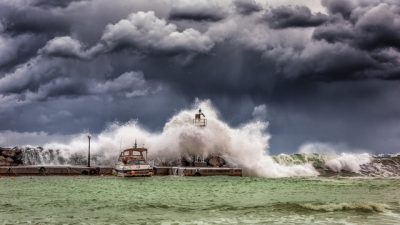 Bad weather is always a danger when at sea. A good boater must know a thing or two about forecasting the weather. But the thing is, the weather may be unpredictable at times, even if storm signals were predicted, you can never tell the extremeness of its wrath in the open sea. This is why every boater should be equipped with proper safety boat handling skills.
Bad weather is always a danger when at sea. A good boater must know a thing or two about forecasting the weather. But the thing is, the weather may be unpredictable at times, even if storm signals were predicted, you can never tell the extremeness of its wrath in the open sea. This is why every boater should be equipped with proper safety boat handling skills.
There’s so much to learn about safe boat handling during bad weather. Here, we’ve listed the basics for you.
Avoid it
The simplest way to avoid a storm is to know when it’s coming. Marine forecast is widely available for recreational boaters and sailors. If a storm is forecasted, the best thing to do is to postpone a trip until the weather gets better.
However, for all-day boating and sailing, sudden storms that happen in the middle of the sea can be hard to predict. Here’s where seamanship can bring you and your boat to safety. But first, you have to equip yourself with the right skills.
Prepare yourself beforehand
They say ‘a good captain sinks with his ship’, but we say, a good boatman knows how to steer his boat into safety. It is recommended to prepare for a storm by training yourself on skills like geography, reading the wind, and some knowledge about waves and currents.
It’s never the same storm twice. For a boater who is not knowledgeable on these things, it will be hard to figure it out when you’ve finally come face-to-face with one. Basic wind, current, and sea knowledge will come in handy especially in tough situations like bad weathers.
Study the waves
Okay, so you failed to know that a storm will be coming and found yourself in the midst of a crazy one. First, you have to study the movement of the waves. This will help you direct your boat into the safest direction possible.
 The most dangerous are waves that are perpendicular to your boat’s side, or ‘beam waves’. With big waves in this direction, excessive rolling or yawing can make your load shift and lose control. The best way to deal with this is steer your boat and run the waves at a 45 degree angle. This may cause you to run in a zigzag direction to be able to reach your destination safely.
The most dangerous are waves that are perpendicular to your boat’s side, or ‘beam waves’. With big waves in this direction, excessive rolling or yawing can make your load shift and lose control. The best way to deal with this is steer your boat and run the waves at a 45 degree angle. This may cause you to run in a zigzag direction to be able to reach your destination safely.
‘Following seas’ is another movement when the wave’s direction comes from behind your boat. Waves like this can be considered safer as you are riding in its direction. However, when big waves form and your boat goes over the wave, your boat can land by the bow, making it topple over, causing a broach. You can counter this effect by riding at the back of a wave, and moderating your speed in accordance to the wave so you can maintain that position.
Beware of high winds
Another thing to take into account when risking to travel the stormy seas is the high winds. Aside from ruining your sail, it can also add to the fast build-up of the waves.
Shut doors and windows, and compartments tightly to avoid excess water from coming in. This is why investing on high quality boat window glass makes your boat safer to deal with stormy seas. For open boats, have your passengers sit at the center part and low bottom of the boat. Make sure everyone is wearing a life jacket.
While it’s recommended to dock immediately during a weather like this, you should take your time while riding the waves. Speed must be reduced in accordance to the wave. Slowing down will produce lesser strain to the hull and your boat’s superstructure. Run your craft at a 45 degree angle to the wind and find ways to make progress in reaching the dock.
Make it through limited visibility
 With heavy rains, there’s a high chance of reduced visibility. Fogs, though rare, can also happen when at the middle of the sea. It’s easy to panic at this time because an operator will have a hard time locating the direction, and will be blinded from detecting obstructions like rocks, or other boats at sea.
With heavy rains, there’s a high chance of reduced visibility. Fogs, though rare, can also happen when at the middle of the sea. It’s easy to panic at this time because an operator will have a hard time locating the direction, and will be blinded from detecting obstructions like rocks, or other boats at sea.
The best way to handle your boat safely in this situation is to remember these four things: (1) Slow down, (2) Turn navigation lights on, (3) Blast your horn, faster when in motion, slower and longer while static, and (4) Fix your position.
Handling your boat during bad weather is one, but making sure that your boat can make it in one piece is another. Both are important to make sure you and your passengers make it safely to the dock. You should never turn a blind eye on purchasing high quality parts, and repairing damages on your boat, especially when it comes to window glass.
Have one of us at Motion Windows help you figure out your window glass repair needs. Simply call or send us a message so we can assist you better.
